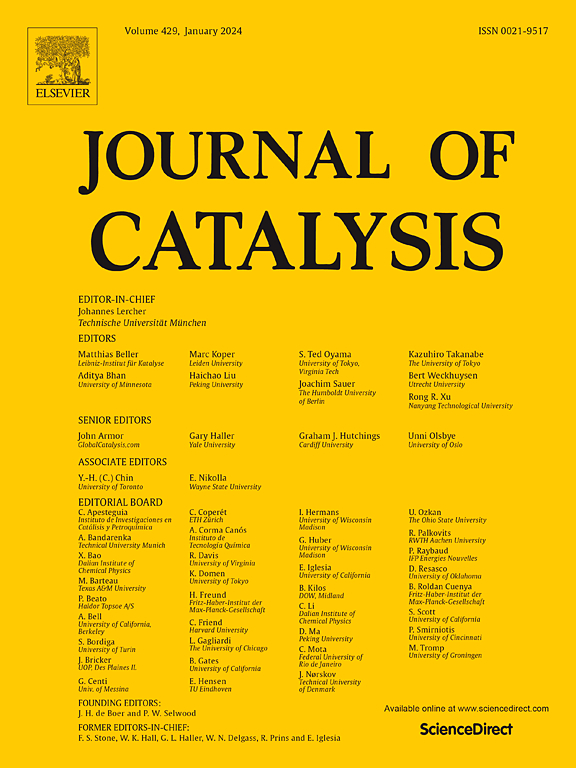Binuclear and mononuclear active sites of porous tin-organic frameworks for selective epimerization of D-glucose into D-mannose
IF 6.5
1区 化学
Q2 CHEMISTRY, PHYSICAL
引用次数: 0
Abstract
Porous tin-organic frameworks (Sn-OFs) are composed of Lewis acid Sn4+ sites connected via organic linkers by tin-carbon covalent bonds. Although high activity of Sn-OFs for selective epimerization of D-glucose into D-mannose has been reported, the roles of different active sites of the Sn-OFs in catalysis remain under debate. Herein, four Sn-OFs with different aromatic linkers were synthesized and characterized using elemental analysis, low-temperature N2 adsorption, and SEM, along with ATR-IR, 1H, 13C, and 119Sn MAS NMR, XANES and EXAFS spectroscopies. Comparative studies with organotin model molecules revealed tetraaryltin Ar4Sn as major structural element of the Sn-OFs with additional sites including dimers Ar3Sn![]() O
O![]() SnAr3, alkylaryltin sites nBuxAr(4-x)Sn, and SnO2. Catalytic tests of the respective organotin molecules suggest Ar4Sn and Ar3Sn
SnAr3, alkylaryltin sites nBuxAr(4-x)Sn, and SnO2. Catalytic tests of the respective organotin molecules suggest Ar4Sn and Ar3Sn![]() O
O![]() SnAr3 as active sites for the epimerization, whereas the activity of the latter binuclear sites appears to be superior. In contrast, nBuxAr(4-x)Sn alkylaryltin sites and SnO2 contributed to the formation of side products, converting D-glucose into D-fructose. The Sn-OFs with symmetrical linkers are more structured materials exhibiting higher catalytic activity than the Sn-OFs with asymmetrical linkers. These findings clarify the roles of various Sn sites in Sn-OFs, advancing understanding of their catalytic behavior.
SnAr3 as active sites for the epimerization, whereas the activity of the latter binuclear sites appears to be superior. In contrast, nBuxAr(4-x)Sn alkylaryltin sites and SnO2 contributed to the formation of side products, converting D-glucose into D-fructose. The Sn-OFs with symmetrical linkers are more structured materials exhibiting higher catalytic activity than the Sn-OFs with asymmetrical linkers. These findings clarify the roles of various Sn sites in Sn-OFs, advancing understanding of their catalytic behavior.


d -葡萄糖选择性外聚成d -甘露糖的多孔锡有机骨架的双核和单核活性位点
多孔锡-有机骨架(Sn-OFs)由路易斯酸Sn4+位点组成,通过锡-碳共价键有机连接。尽管有报道称Sn-OFs对d -葡萄糖选择性外聚成d -甘露糖具有高活性,但Sn-OFs的不同活性位点在催化过程中的作用仍存在争议。本文采用元素分析、低温N2吸附、SEM、ATR-IR、1H、13C和119Sn MAS NMR、XANES和EXAFS等光谱对四种具有不同芳香连接剂的Sn-OFs进行了表征。与有机锡模型分子的比较研究表明,四芳基锡Ar4Sn是Sn- ofs的主要结构元素,其他位点包括二聚体Ar3SnOSnAr3、烷基芳基锡nBuxAr(4-x)Sn和SnO2。有机锡分子的催化实验表明,Ar4Sn和Ar3SnOSnAr3是外显异构化的活性位点,而后者的活性似乎更强。相反,nBuxAr(4-x)Sn烷基芳基锡位点和SnO2促进了副产物的形成,将d -葡萄糖转化为d -果糖。对称连接的Sn-OFs比不对称连接的Sn-OFs具有更高的催化活性。这些发现阐明了Sn- ofs中不同Sn位点的作用,促进了对其催化行为的理解。
本文章由计算机程序翻译,如有差异,请以英文原文为准。
求助全文
约1分钟内获得全文
求助全文
来源期刊

Journal of Catalysis
工程技术-工程:化工
CiteScore
12.30
自引率
5.50%
发文量
447
审稿时长
31 days
期刊介绍:
The Journal of Catalysis publishes scholarly articles on both heterogeneous and homogeneous catalysis, covering a wide range of chemical transformations. These include various types of catalysis, such as those mediated by photons, plasmons, and electrons. The focus of the studies is to understand the relationship between catalytic function and the underlying chemical properties of surfaces and metal complexes.
The articles in the journal offer innovative concepts and explore the synthesis and kinetics of inorganic solids and homogeneous complexes. Furthermore, they discuss spectroscopic techniques for characterizing catalysts, investigate the interaction of probes and reacting species with catalysts, and employ theoretical methods.
The research presented in the journal should have direct relevance to the field of catalytic processes, addressing either fundamental aspects or applications of catalysis.
 求助内容:
求助内容: 应助结果提醒方式:
应助结果提醒方式:


